Matching Optimization of a Mixed Flow Pump Impeller and Diffuser Based on the Inverse Design Method
Abstract
1. Introduction
2. Mixed Flow Pump Model
3. Optimization Strategy
3.1. 3D Inverse Design Method
3.2. CFD Analyses and Validation
3.3. Optimization Process
4. Redesign Setting
4.1. Design Parameters
4.2. Optimization Setting
4.3. Optimization Result
5. Performance Comparison and Analysis
6. Conclusions
- After the first step of optimization, the weighted efficiency of the optimized impeller A is 1.63% higher than the baseline impeller. In detail, the impeller efficiency of the optimized impeller A at 1.2Qdes and 1.0Qdes is 5.5% and 0.79% higher than the baseline impeller, respectively, but 0.56% lower at 0.8Qdes. Besides, the best efficiency point in the optimized impeller A is consistent with the design point, while in the baseline impeller, the best efficiency point appears at small flow conditions.
- In the matching optimization, the circulation and flow field distribution at the diffuser inlet in IDM was set to be consistent with the optimized impeller outlet, which helps to reduce the hydraulic loss at the diffuser inlet. Compared with the baseline diffuser, the hydraulic loss of the optimized diffuser B at 1.2Qdes, 1.0Qdes, and 0.8Qdes reduced by 0.09%, 1.47%, and 0.54%, respectively.
- The diffuser has a great impact on the hydraulic loss of downstream components. The hydraulic loss of the optimized model outlet pipe at 1.2Qdes, 1.0Qdes, and 0.8Qdes is 0.84%, 1.37%, and 0.83% lower than the baseline diffuser outlet pipe, respectively.
- In total, the pump efficiency of the optimized model at 1.2Qdes, 1.0Qdes, and 0.8Qdes is 80.31%, 88.89% and 81.30%, respectively. These efficiencies correspond to 6.47%, 3.68%, and 0.82% improvement over the baseline model.
Author Contributions
Funding
Institutional Review Board Statement
Informed Consent Statement
Data Availability Statement
Acknowledgments
Conflicts of Interest
Nomenclature
| Specific speed | |
| Q | Volume flow rate |
| Pump head | |
| Relative velocity | |
| Tangential velocity | |
| Radius | |
| Periodic velocity | |
| Rotational speed | |
| B | Blade number |
| Static pressure at blade surface | |
| m | Streamline |
| Circumferential average absolute velocity | |
| Pump efficiency | |
| Total pressure | |
| Torque | |
| Angular velocity | |
| Density of the fluid | |
| Wrap angle | |
| Angular velocity | |
| Superscripts | |
| + | Work surface |
| - | Suction surface |
| ~ | Normalization |
| Subscripts | |
| h | Hub |
| s | Shroud |
References
- Wu, J.; Shimmei, K.; Tani, K.; Niikura, K.; Sato, J. CFD-Based Design Optimization for Hydro Turbines. J. Fluids Eng. 2007, 129, 159–168. [Google Scholar] [CrossRef]
- Ma, Z.; Zhu, B.S.; Rao, C.; Shangguan, Y.H. Comprehensive Hydraulic Improvement and Parametric Analysis of a Francis Turbine Runner. Energies 2019, 12, 307. [Google Scholar] [CrossRef]
- Chikh, M.A.A.; Belaidi, I.; Khelladi, S.; Hamrani, A.; Bakir, F. Coupling of Inverse Method and Cuckoo Search Algorithm for Multiobjective Optimization Design of an Axial Flow Pump. Proc. Inst. Mech. Eng. Part A J. Power Energy 2019, 233, 988–1006. [Google Scholar] [CrossRef]
- Meng, F.; Li, Y.; Yuan, S.; Wang, W.; Zheng, Y.; Osman, M.K. Multiobjective Combination Optimization of an Impeller and Diffuser in a Reversible Axial-Flow Pump Based on a Two-Layer Artificial Neural Network. Processes 2020, 8, 309. [Google Scholar] [CrossRef]
- Shi, L.; Zhu, J.; Tang, F.; Wang, C. Multi-Disciplinary Optimization Design of Axial-Flow Pump Impellers Based on the Approximation Model. Energies 2020, 13, 779. [Google Scholar] [CrossRef]
- Pei, J.; Gan, X.; Wang, W.; Yuan, S.; Tang, Y. Multi-objective Shape Optimization on the Inlet Pipe of a Vertical Inline Pump. J. Fluids Eng. 2019, 141, 061108. [Google Scholar] [CrossRef]
- Wang, W.J.; Yuan, S.Q.; Pei, J.; Zhang, J.F. Optimization of the Diffuser in a Centrifugal Pump by Combining Response Surface Method with Multi-island Genetic Algorithm. Proc. Inst. Mech. Eng. Part E J. Process. Mech. Eng. 2017, 231, 191–201. [Google Scholar] [CrossRef]
- Shim, H.S.; Afzal, A.; Kim, K.Y.; Jeong, H.S. Three-objective Optimization of a Centrifugal Pump with Double Volute to Minimize Radial Thrust at Off-design Conditions. Proc. Inst. Mech. Eng. Part A J. Power Energy 2016, 230, 598–615. [Google Scholar] [CrossRef]
- Kim, S.; Jeong, U.-B.; Lee, K.-Y.; Kim, J.-H.; Yoon, J.-Y.; Choi, Y.-S. Multi-objective Optimization for Mixed-flow Pump with Blade Angle of Impeller Exit and Diffuser Inlet. J. Mech. Sci. Technol. 2017, 31, 5099–5106. [Google Scholar]
- Suh, J.-W.; Yang, H.-M.; Kim, Y.-I.; Lee, K.-Y.; Kim, J.-H.; Joo, W.-G.; Choi, Y.-S. Multi-objective Optimization of a High Efficiency and Suction Performance for Mixed-flow Pump Impeller. Eng. Appl. Comput. Fluid Mech. 2019, 13, 744–762. [Google Scholar] [CrossRef]
- Zangeneh, M. A Compressible 3D Design Method for Radial and Mixed Flow Turbomachinery Blades. Int. J. Numer. Methods Fluids 1991, 13, 599–624. [Google Scholar] [CrossRef]
- Goto, A.; Takemura, T.; Zangeneh, M. Suppression of Secondary Flows in a Mixed-Flow Pump Impeller by Application of Three-Dimensional Inverse Design Method: Part 2—Experimental Validation. J. Turbomach. 1996, 118, 544–551. [Google Scholar] [CrossRef]
- Zangeneh, M.; Goto, A.; Takemura, T. Suppression of Secondary Flows in a Mixed-Flow Pump Impeller by Application of Three-Dimensional Inverse Design Method: Part 1—Design and Numerical Validation. J. Turbomach. 1996, 118, 536–543. [Google Scholar] [CrossRef]
- Huang, R.F.; Luo, X.W.; Ji, B.; Wang, P.; Yu, A.; Zhai, Z.H.; Zhou, J.J. Multi-objective Optimization of a Mixed-Flow Pump Impeller Using Modified NSGA-II Algorithm. Sci. China Technol. Sci. 2015, 58, 2111–2130. [Google Scholar] [CrossRef]
- Yiu, K.F.C.; Zangeneh, M. Three-Dimensional Automatic Optimization Method for Turbomachinery Blade Design. J. Propuls. Power 2000, 16, 1174–1181. [Google Scholar] [CrossRef]
- Zhu, Y.J.; Ju, Y.P.; Zhang, C.H. An Experience-independent Inverse Design Optimization Method of Compressor Cascade Airfoil. J. Power Energy 2018, 233, 431–442. [Google Scholar] [CrossRef]
- Zhu, B.; Wang, X.; Tan, L.; Zhou, D.; Zhao, Y.; Cao, S. Optimization Design of a Reversible Pump–Turbine Runner with High Efficiency and Stability. Renew. Energy 2015, 81, 366–376. [Google Scholar] [CrossRef]
- Yang, W.; Xiao, R.F. Multiobjective Optimization Design of a Pump–turbine Impeller Based on an Inverse Design using a Combination Optimization Strategy. J. Fluid. Eng. 2014, 136, 249–256. [Google Scholar] [CrossRef]
- Zangeneh, M.; Daneshkhah, K. A Fast 3D Inverse Design Based Multi-Objective Optimization Strategy for Design of Pumps. In Proceedings of the ASME 2009 Fluids Engineering Division Summer Meeting, Vail, CO, USA, 2–6 August 2009. [Google Scholar]
- Wang, P.; Vera-Morales, M.; Vollmer, M.; Zangeneh, M.; Zhu, B.S.; Ma, Z. Optimization of a Pump-as-turbine Runner Using a 3D Inverse Design Methodology. In Proceedings of the 29th IAHR Symposium on Hydraulic Machinery and Systems, Kyoto, Japan, 16–21 September 2018; Volume 240. [Google Scholar]
- Bonaiuti, D.; Zangeneh, M. On the Coupling of Inverse Design and Optimization Techniques for the Multiobjective, Multipoint Design of Turbomachinery Blades. J. Turbomach. 2009, 131, 134–149. [Google Scholar]
- Bonaiuti, D.; Zangeneh, M.; Aartojarvi, R.; Eriksson, J. Parametrical Design of a Waterjet Pump by Means of Inverse Design, CFD Calculations and Experimental Analyses. J. Fluid. Eng. 2010, 132, 201–215. [Google Scholar] [CrossRef]
- Yang, W.; Lei, X.; Zhang, Z.; Li, H.; Wang, F. Hydraulic Design of Submersible Axial-flow Pump Based on Blade Loading Distributions. Trans. Chin. Soc. Agric. Mach. 2017, 48, 179–187. (In Chinese) [Google Scholar]
- Yin, J.; Wang, D. Review on Applications of 3D Inverse Design Method for Pump. Chin. J. Mech. Eng. 2014, 27, 520–527. [Google Scholar] [CrossRef]
- Hawthorne, W.R.; Wang, C.; Tan, C.S.; McCune, J.E. Theory of blade design for large deflections: Part I-Two dimensional cascades. Trans. ASME J. Eng. Gas Turb. Power 1984, 106, 346353. [Google Scholar] [CrossRef]
- Hellsten, A.; Laine, S. Extension of the k-omega-SST Turbulence Model for Flows over Rough Surfaces. In Proceedings of the 22nd Atmospheric Flight Mechanics Conference, New Orleans, LA, USA, 11–13 August 1997. [Google Scholar]
- Menter, F.R.; Galpin, P.F.; Esch, T.; Kuntz, M.; Berner, C. CFD Simulations of Aerodynamic Flows with a Pressure-based Method. In Proceedings of the 24th International congress of the aeronautical sciences, Yokohama, Japan, 29 August–3 September 2004. [Google Scholar]
- Pebesma, E.J.; Heuvelink, G.B. Latin Hypercube Sampling of Gaussian Random Fields. Technometrics 1999, 41, 303–312. [Google Scholar] [CrossRef]
- Coello, C.A.C. A Comprehensive Survey of Evolutionary-Based Multiobjective Optimization Techniques. Knowl. Inf. Syst. 1999, 1, 269–308. [Google Scholar] [CrossRef]
- Srinivas, N.; Deb, K. Multiobjective Optimization Using Nondominated Sorting in Genetic Algorithms. Evolut. Comput. 1994, 2, 221–248. [Google Scholar] [CrossRef]
- Wang, M.C.; Li, Y.J.; Yuan, J.P.; Meng, F.; Appiah, D.; Chen, J.Q. Comprehensive Improvement of Mixed-flow Pump Impeller Based on Multi-objective Optimization. Processes 2020, 8, 905. [Google Scholar] [CrossRef]
- Wang, M.C.; Li, Y.J.; Yuan, J.P.; Chen, J.Q.; Zheng, Y.H.; Yang, P.H. Performance of Mixed Flow Pump under Condition of Non-linear Distribution of Impeller Exit Circulation. Chin. Soc. Agric. Mach. 2020, 51, 204–211. (In Chinese) [Google Scholar]
- Chang, S.P.; Shi, Y.F.; Zhou, C.; Ding, J. Effect of Exit Circulation Distribution on Performances of Mixed-flow Pump. Trans. Chin. Soc. Agric. Mach. 2014, 45, 89–93. (In Chinese) [Google Scholar]
- Zhu, B.S.; Tan, L.; Wang, X.H.; Ma, Z. Investigation on Flow Characteristics of Pump-Turbine Runners with Large Blade Lean. J. Fluids Eng. 2017, 140. [Google Scholar] [CrossRef]
- Zhang, P.Y.; Zhu, B.S.; Zhang, L.F. Numerical Investigation on Pressure Fluctuations Induced by Interblade Vortices in a Runner of Francis Turbine. Large Electron. Mach. Hydraul. Turbine 2009, 35, 35–38. (In Chinese) [Google Scholar]
- Zangeneh, M.; Goto, A.; Harada, H. On the Design Criteria for Suppression of Secondary Flows in Centrifugal and Mixed Flow Impellers. J. Turbomach. 1998, 120, 723. [Google Scholar] [CrossRef]
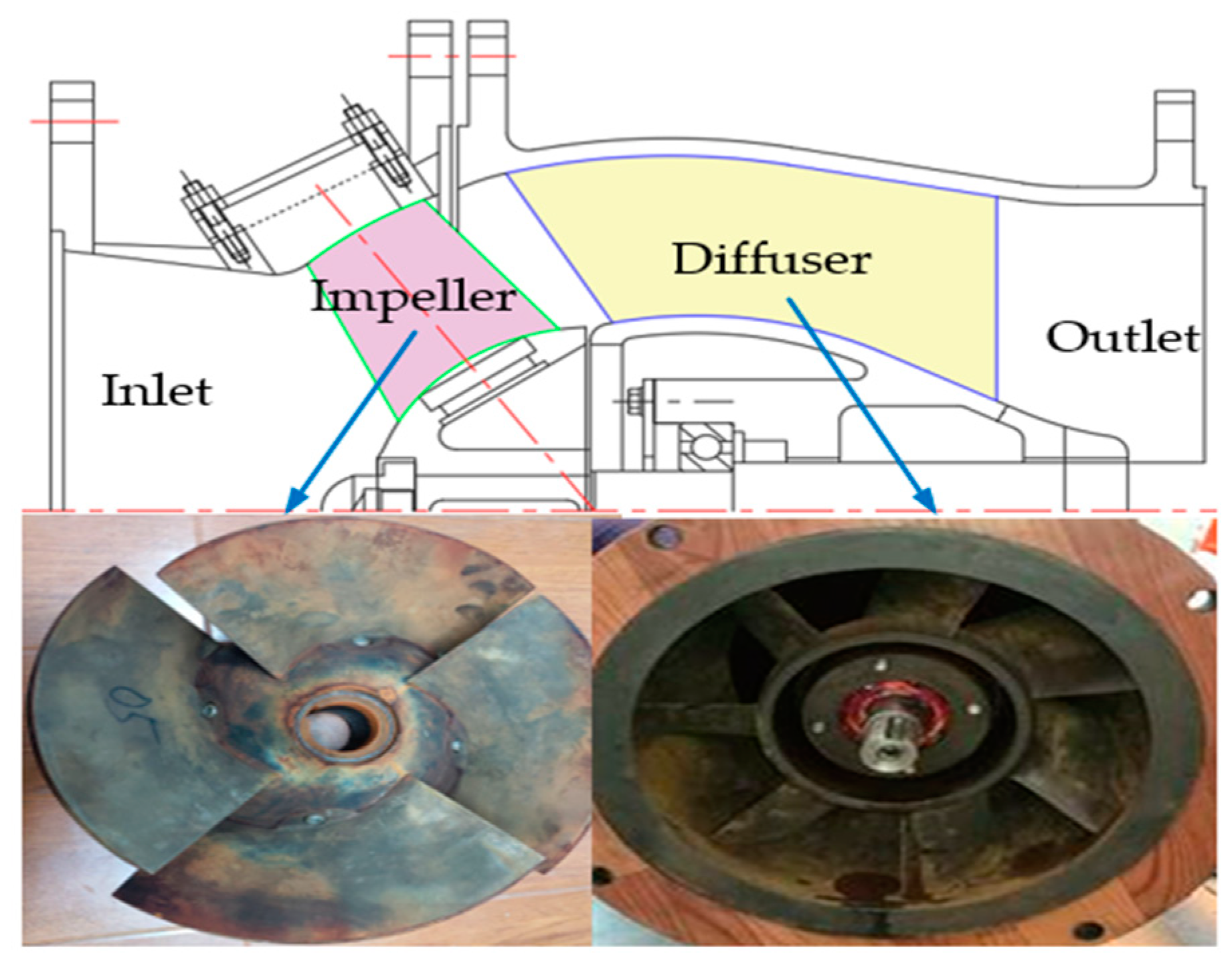
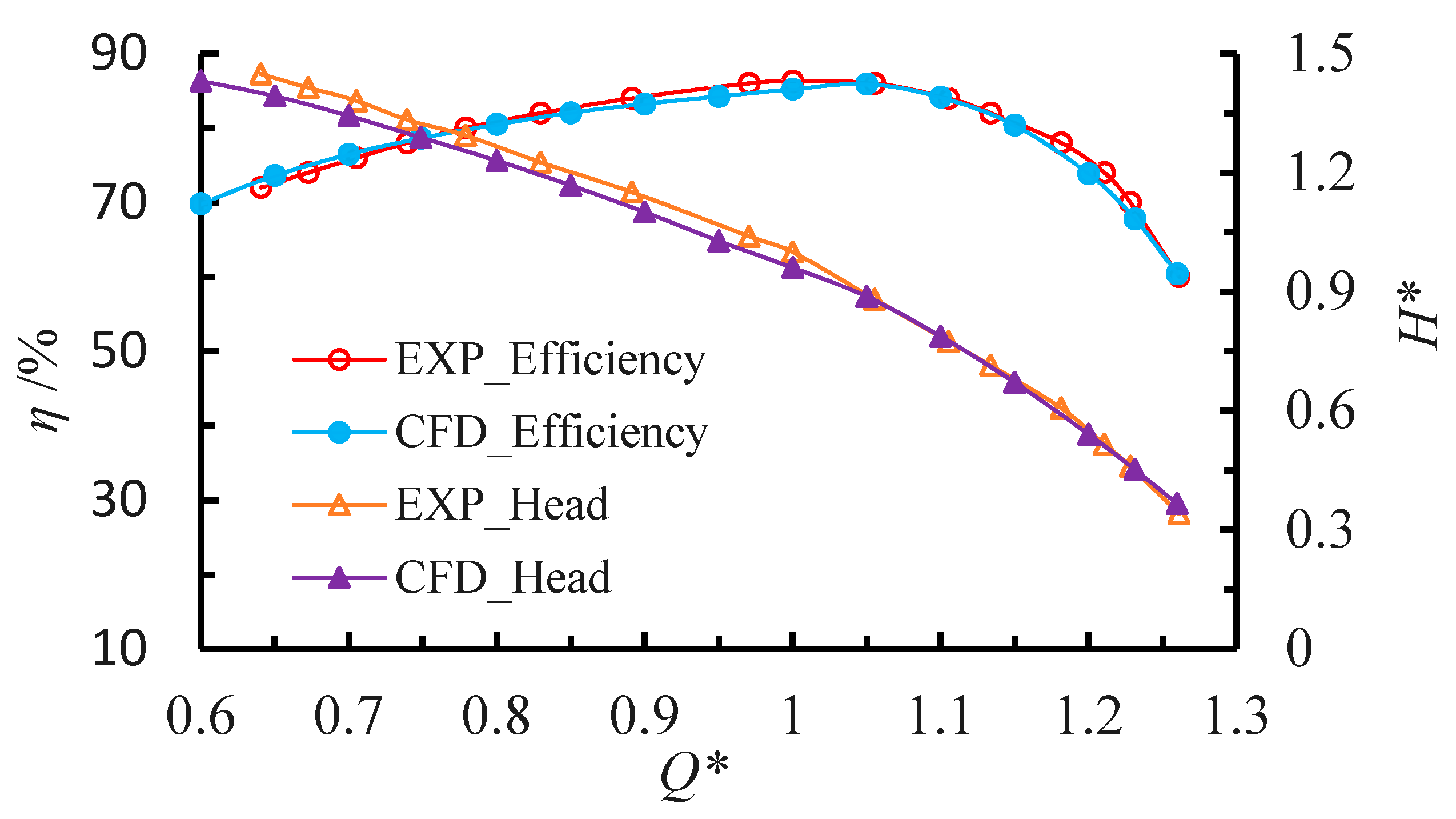
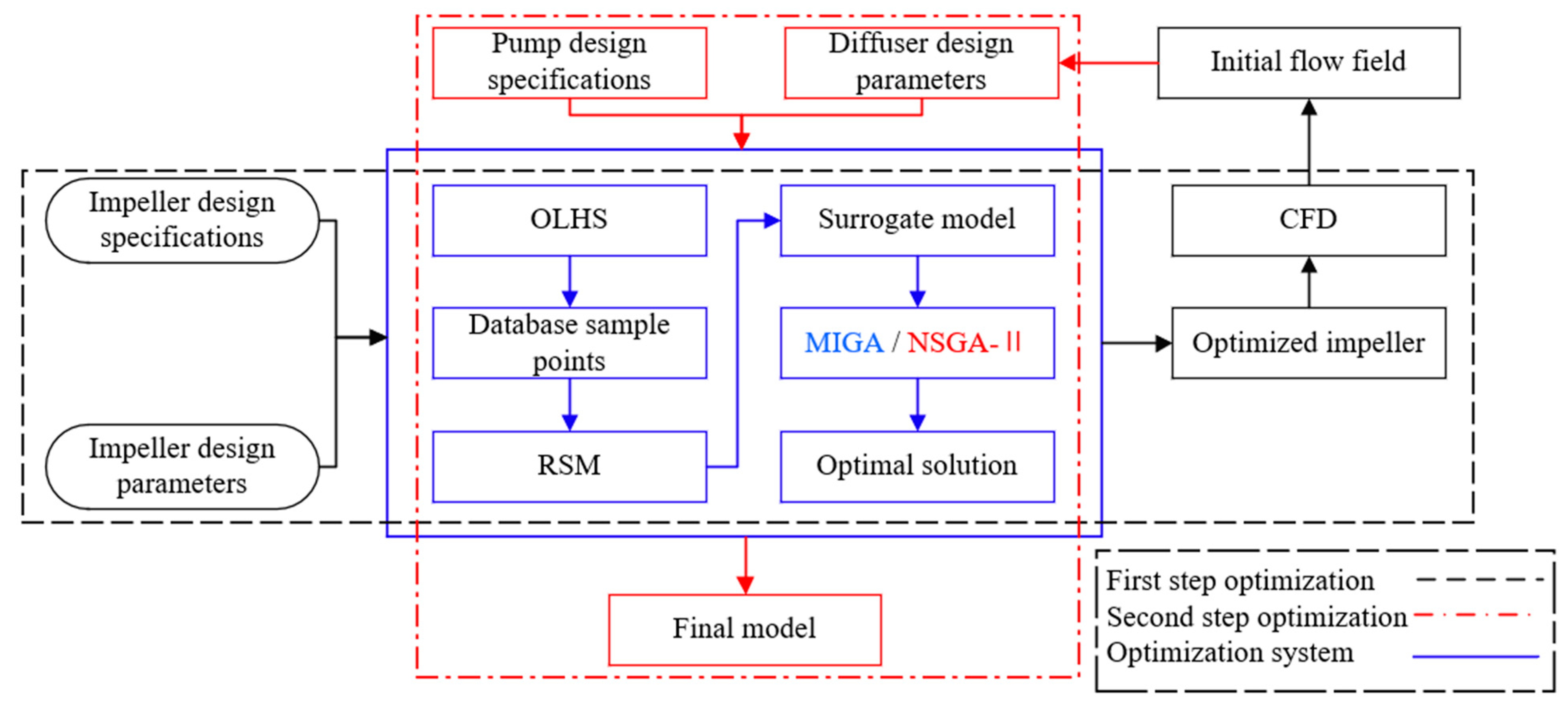

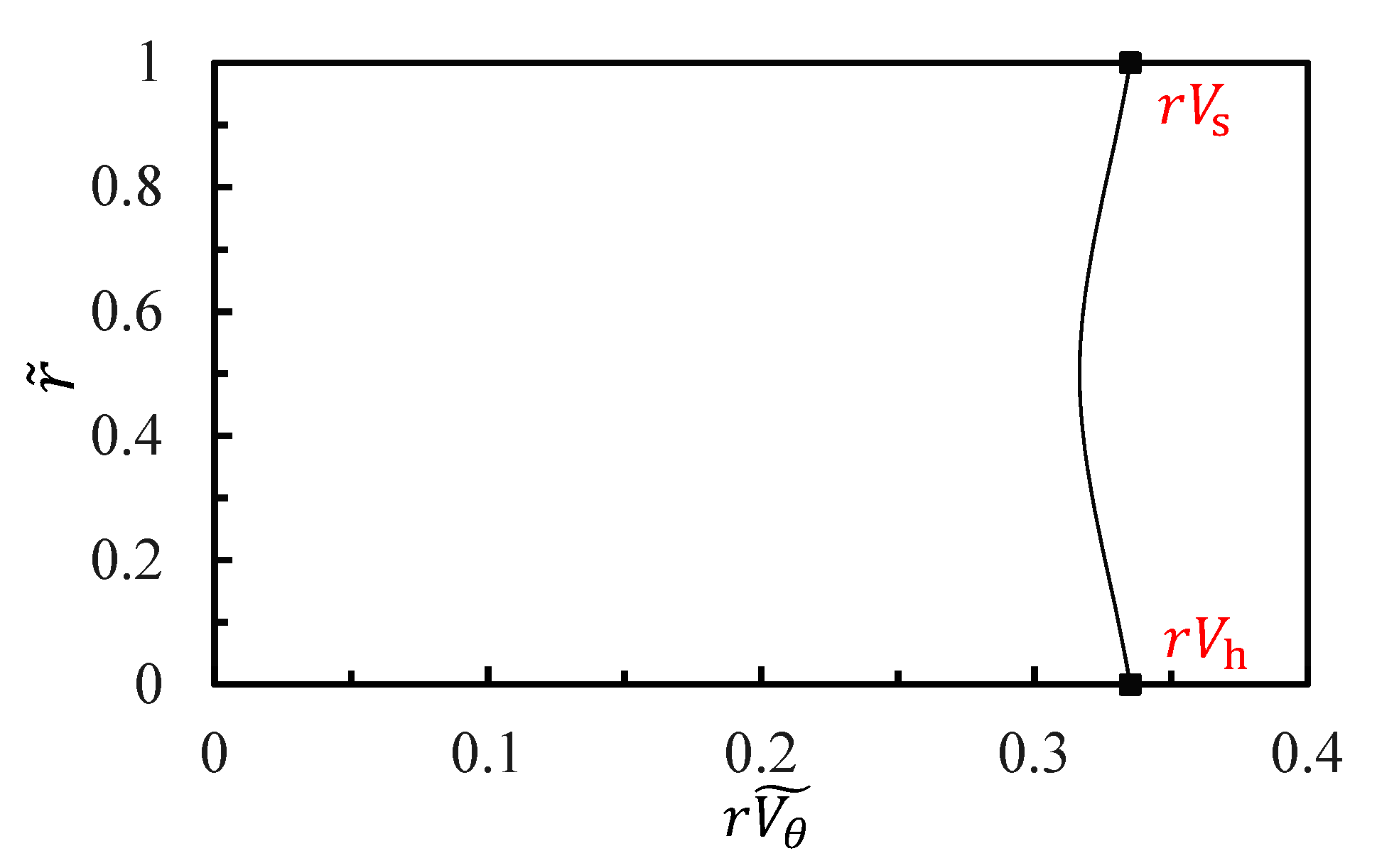
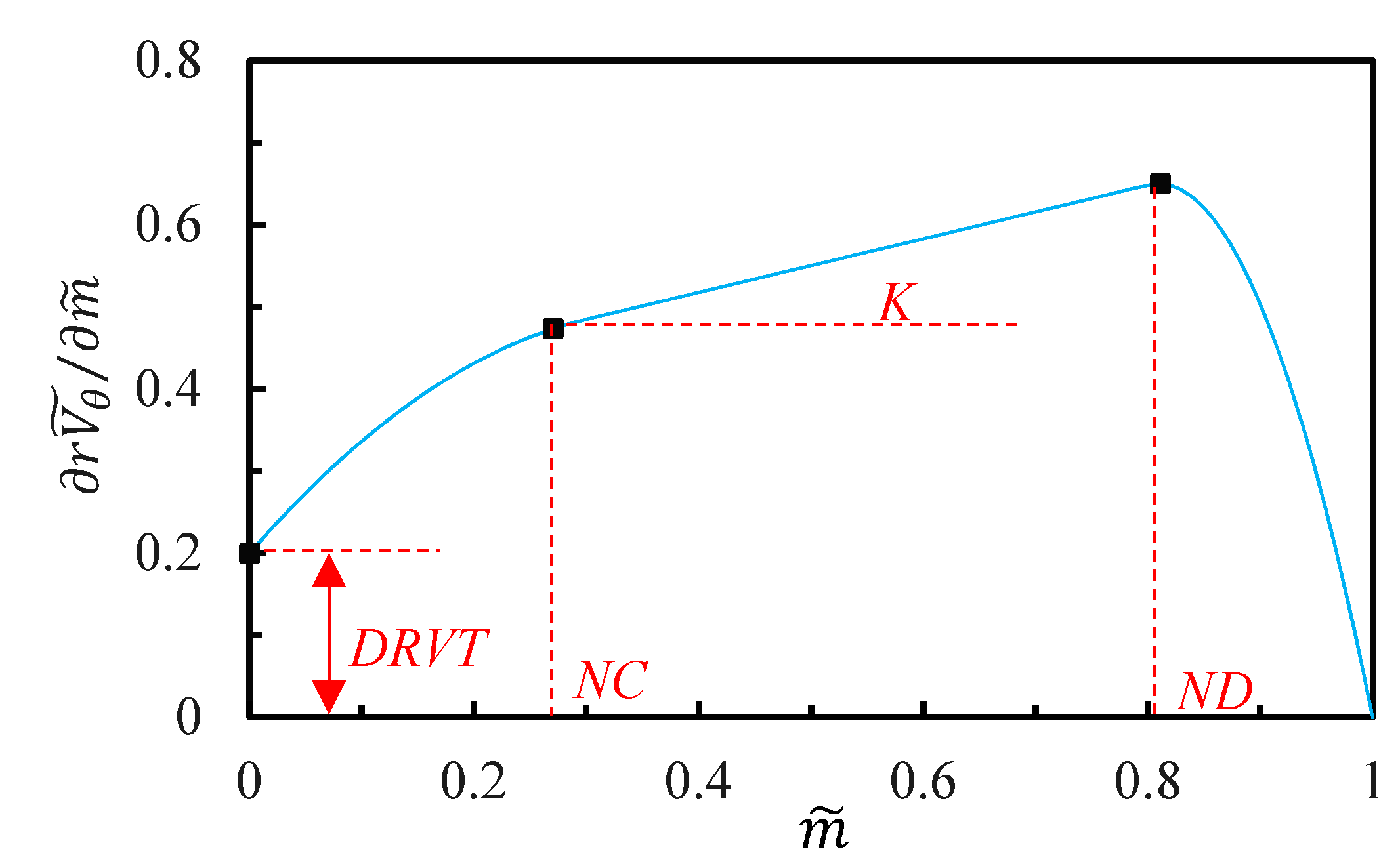



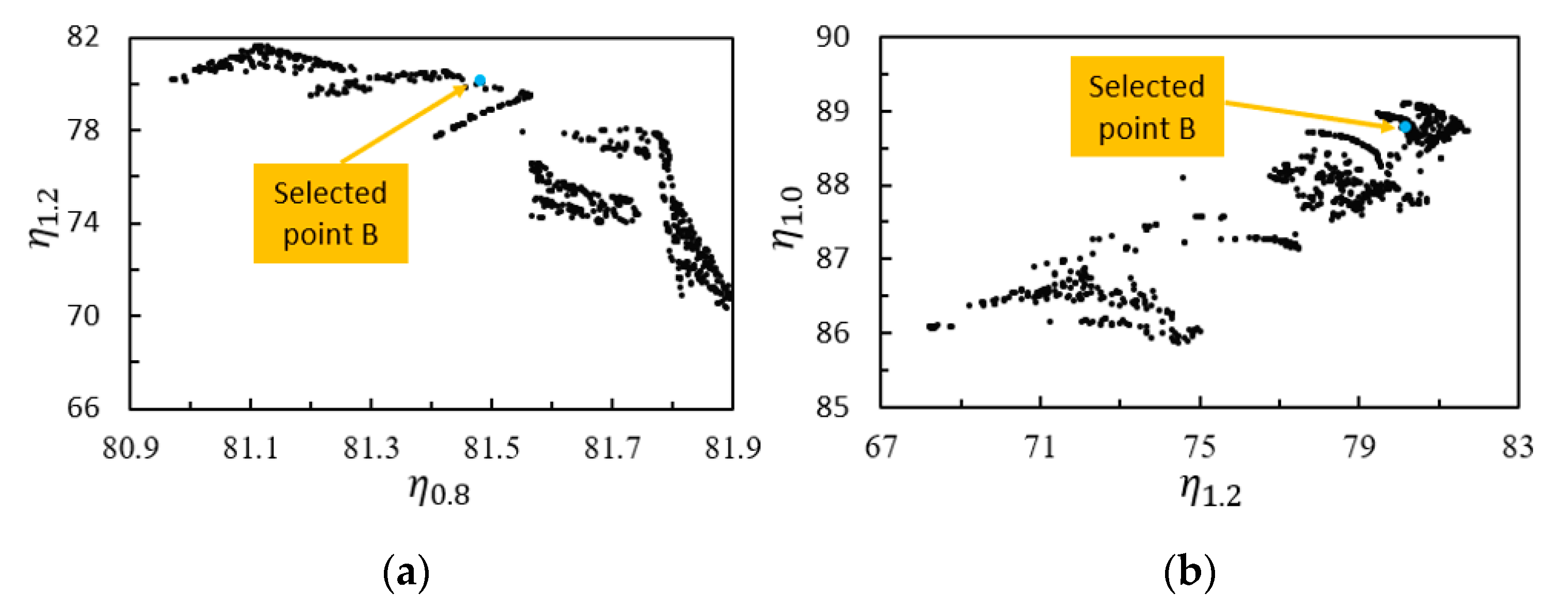

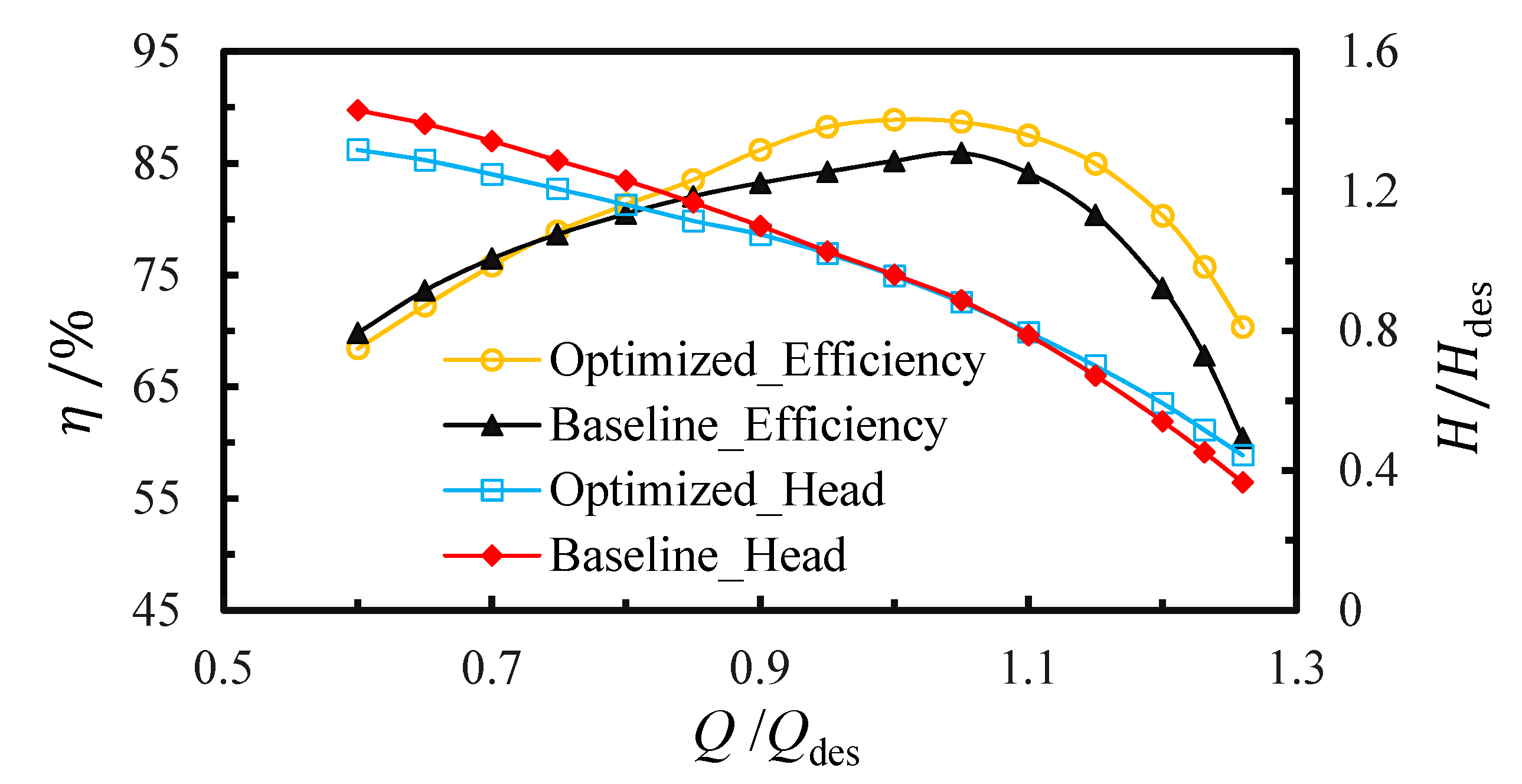
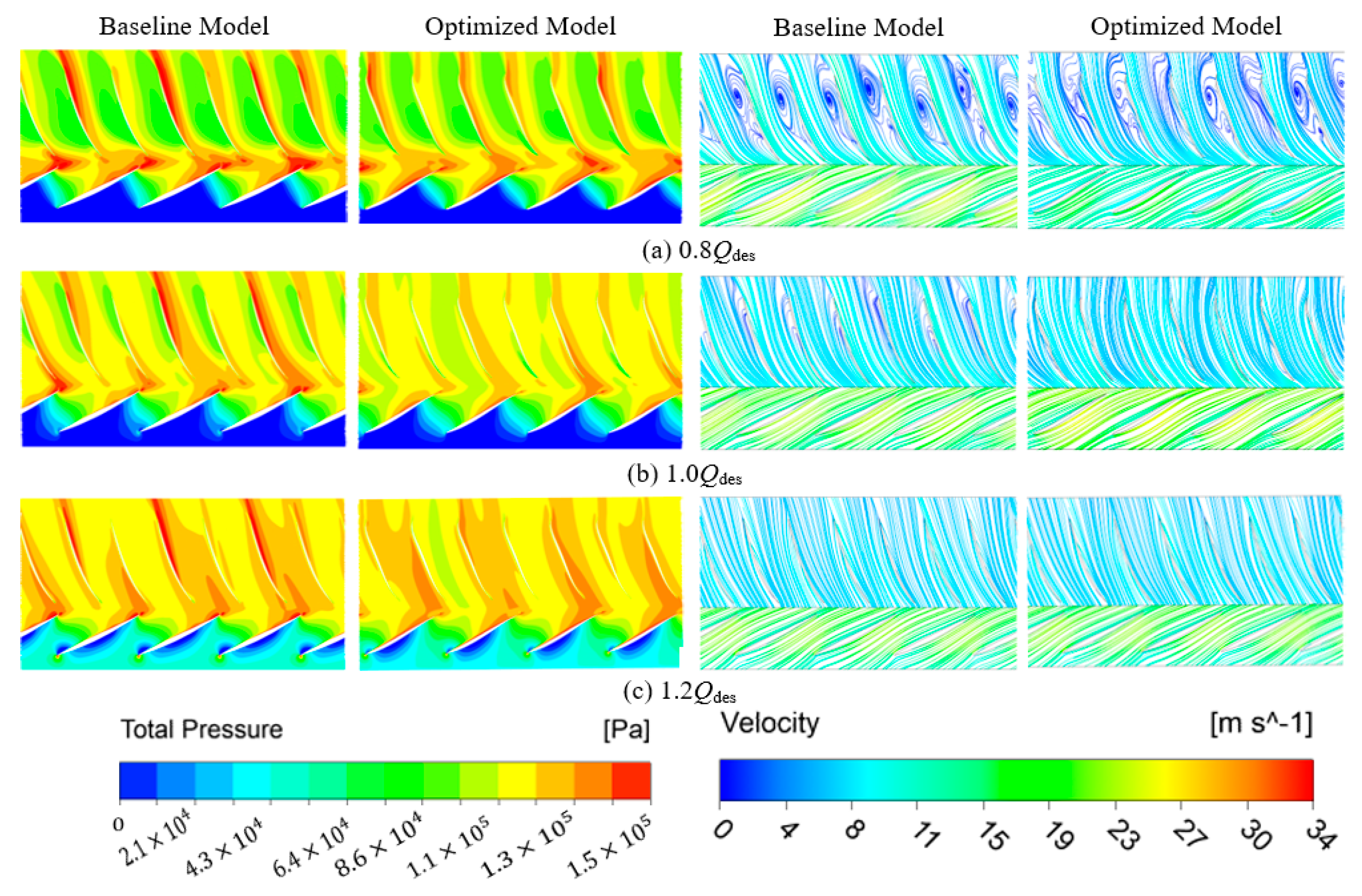
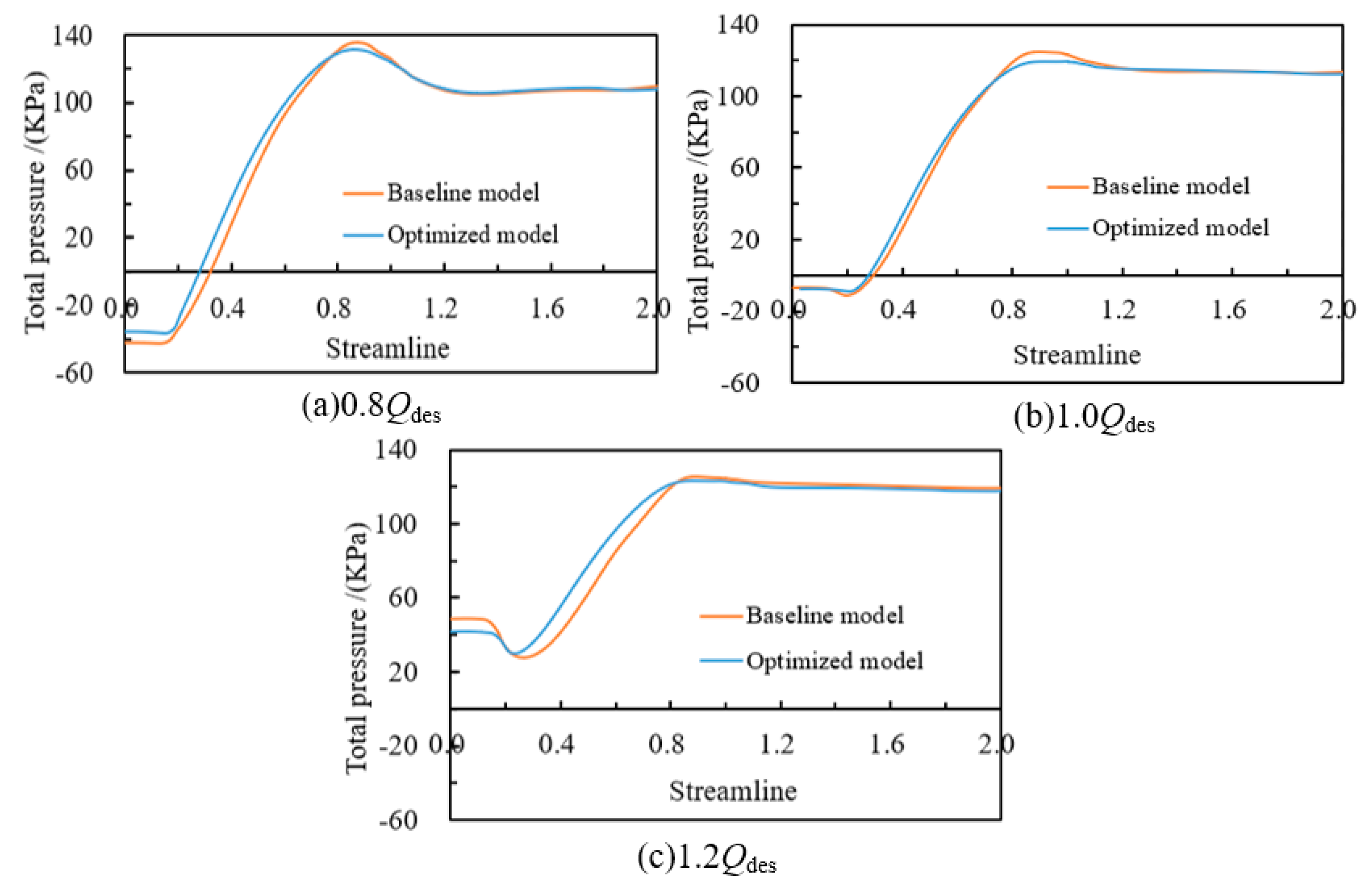
| Inlet Pipe | Impeller | Diffuser | Outlet Pipe | Total Number | Head (m) | Efficiency (%) |
|---|---|---|---|---|---|---|
| 43 | 63 | 70 | 58 | 234 | 12.13 | 84.52 |
| 83 | 121 | 130 | 95 | 429 | 12.11 | 84.92 |
| 83 | 141 | 152 | 95 | 471 | 12.10 | 85.21 |
| 118 | 172 | 187 | 133 | 610 | 12.12 | 85.19 |
| 167 | 241 | 269 | 172 | 849 | 12.11 | 85.23 |
| First Step of Optimization | Second Step of Optimization | |||||
|---|---|---|---|---|---|---|
| Type | Parameters | Range | Type | Parameters | Range | |
| Design parameters | Circulation | 0.29~0.34 | Blade loading | −0.2~0.2 | ||
| 0.29~0.34 | 0.1–0.5 | |||||
| Blade loading | −0.2~0.2 | 0.5~0.9 | ||||
| 0.1~0.5 | −1.0~1.0 | |||||
| 0.5~0.9 | −0.2~0.2 | |||||
| −2.0~2.0 | 0.1~0.5 | |||||
| −0.2~0.2 | 0.5~0.9 | |||||
| 0.1~0.4 | −1.0~1.0 | |||||
| 0.4~0.9 | Stacking | −25.0~25.0 | ||||
| −2.0~2.0 | ||||||
| Stacking | −20.0~20.0 | |||||
| Constraints | Impeller head at design point | Pump head at design point | ||||
| Optimization objectives | Weighted efficiency of the impeller at 0.8Qdes, 1.0Qdes and 1.2Qdes | Pump efficiency at 0.8Qdes | ||||
| Pump efficiency at 1.0Qdes | ||||||
| Pump efficiency at 1.2Qdes | ||||||
| MIGA | NSGA-Ⅱ | ||
|---|---|---|---|
| Setting | Value | Setting | Value |
| Population size | 30 | Population size | 100 |
| Number of generations | 40 | Number of generations | 120 |
| Number of islands | 10 | Crossover probability | 0.9 |
| Crossover probability | 0.9 | Cross distribution index | 10 |
| Mutation probability | 0.05 | Mutation distribution index | 20 |
| Migration probability | 0.05 | Initialization mode | Random |
| Impeller Efficiency | Pump Efficiency | |||||
|---|---|---|---|---|---|---|
| Baseline Impeller | First Step Optimization | Baseline Pump | Second Step Optimization | |||
| RSM | CFD | RSM | CFD | |||
| 95.66 | 95.10 | 80.48 | 81.48 | 81.30 | ||
| 95.05 | 95.84 | 85.21 | 88.55 | 88.89 | ||
| 84.86 | 90.36 | 73.84 | 80.05 | 80.31 | ||
| 92.66 | 94.14 | 94.29 | ||||
| 13.51 | 13.58 | 13.26 | 12.10 | 12.32 | 12.06 | |
| Baseline Model | Optimized Model | |||||||
|---|---|---|---|---|---|---|---|---|
| Inlet | Impeller | Diffuser | Outlet | Inlet | Impeller | Diffuser | Outlet | |
| 0.8Qdes | 0.09% | 4.34% | 9.72% | 4.45% | 0.09% | 4.90% | 9.18% | 3.62% |
| 0.9Qdes | 0.13% | 4.16% | 7.56% | 4.01% | 0.13% | 3.78% | 6.33% | 2.73% |
| 1.0Qdes | 0.18% | 4.95% | 5.32% | 3.40% | 0.18% | 4.16% | 3.85% | 2.03% |
| 1.1Qdes | 0.25% | 8.14% | 3.52% | 2.99% | 0.25% | 5.65% | 3.33% | 2.16% |
| 1.2Qdes | 0.37% | 15.14% | 5.13% | 3.92% | 0.36% | 9.64% | 5.04% | 3.08% |
Publisher’s Note: MDPI stays neutral with regard to jurisdictional claims in published maps and institutional affiliations. |
© 2021 by the authors. Licensee MDPI, Basel, Switzerland. This article is an open access article distributed under the terms and conditions of the Creative Commons Attribution (CC BY) license (http://creativecommons.org/licenses/by/4.0/).
Share and Cite
Wang, M.; Li, Y.; Yuan, J.; Osman, F.K. Matching Optimization of a Mixed Flow Pump Impeller and Diffuser Based on the Inverse Design Method. Processes 2021, 9, 260. https://doi.org/10.3390/pr9020260
Wang M, Li Y, Yuan J, Osman FK. Matching Optimization of a Mixed Flow Pump Impeller and Diffuser Based on the Inverse Design Method. Processes. 2021; 9(2):260. https://doi.org/10.3390/pr9020260
Chicago/Turabian StyleWang, Mengcheng, Yanjun Li, Jianping Yuan, and Fareed Konadu Osman. 2021. "Matching Optimization of a Mixed Flow Pump Impeller and Diffuser Based on the Inverse Design Method" Processes 9, no. 2: 260. https://doi.org/10.3390/pr9020260
APA StyleWang, M., Li, Y., Yuan, J., & Osman, F. K. (2021). Matching Optimization of a Mixed Flow Pump Impeller and Diffuser Based on the Inverse Design Method. Processes, 9(2), 260. https://doi.org/10.3390/pr9020260








